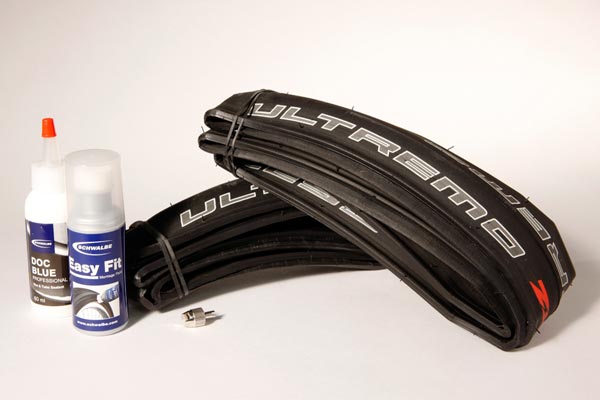Schwalbe Ultremo ZX Tubeless tyres review

The tyres ride well. They feel fast, they're very grippy, make a nice noise and, at 90 - 100 psi, result in fewer lost fillings over our corrugated roads. They can be run even lower, although all but the racing snake may fear bottoming out. We raced the Ultremos in a crit on a smooth, freshly-laid circuit with complete confidence through all the corners, including a hairpin. They handled quick descents on some sketchy surfaces in Italy with similar ease - and notable comfort. As a race tyre, they won't last forever, but 500 miles on a pair shows no signs of cutting up. It pays to re-inject sealant after three months. Air loss between rides is a little bit worse than a clincher, but not much. Punctures? None so far. We fitted them to an American Classics Tubeless rim and to a standard Mavic R SYS rim with identical results. The Mavic comes airtight as standard and although not officially "tubeless", it works a treat. Many wheels don't have airtight rim beds - in which case conversion kits will do the trick.
-
+
No punctures so far
-
+
Light and fast
-
-
Can be messy/fiddly to fit
You can trust Cycling Weekly.
The cycling devil says tubeless tyres are a niche product for nerds, heavy and hard as hell to fit. The cycling angel says they're blissfully puncture-proof, ride like a dream and are no worse to manhandle on to a rim than a clincher.
Schwalbe make big claims for their Ultremo ZX Tubeless, (claimed 295g) trumpeting it as their fastest ever tyre with a weight penalty of under 20g against a tubed set-up. And some reckon it could finally kick-start a tubeless revolution on the road.
Fitting is not quite a breeze, but it's hardly a gale. They slip on, with the supplied slippy liquid to help, with about the same effort as a tight clincher. Avoid tools if at all possible, and use palms not fingers to roll them on, with the bead sitting as low in the rim as you can get it.
Seating the special beads in the rim requires patience. We got it at the third attempt. A track pump to inflate, preferably one that shifts a high volume of air quickly, is essential.
Instructions are on the minimal side, with none for inserting the Doc Blue sealant. The least messy route is to remove the valve core and inject 30g with a big syringe and short length of plastic tube.
The theory goes that pinch flats are impossible with no tube and the sealant will shut down a hole somewhere between quickly and instantly.
The latest race content, interviews, features, reviews and expert buying guides, direct to your inbox!
Founded in 1891, Cycling Weekly and its team of expert journalists brings cyclists in-depth reviews, extensive coverage of both professional and domestic racing, as well as fitness advice and 'brew a cuppa and put your feet up' features. Cycling Weekly serves its audience across a range of platforms, from good old-fashioned print to online journalism, and video.